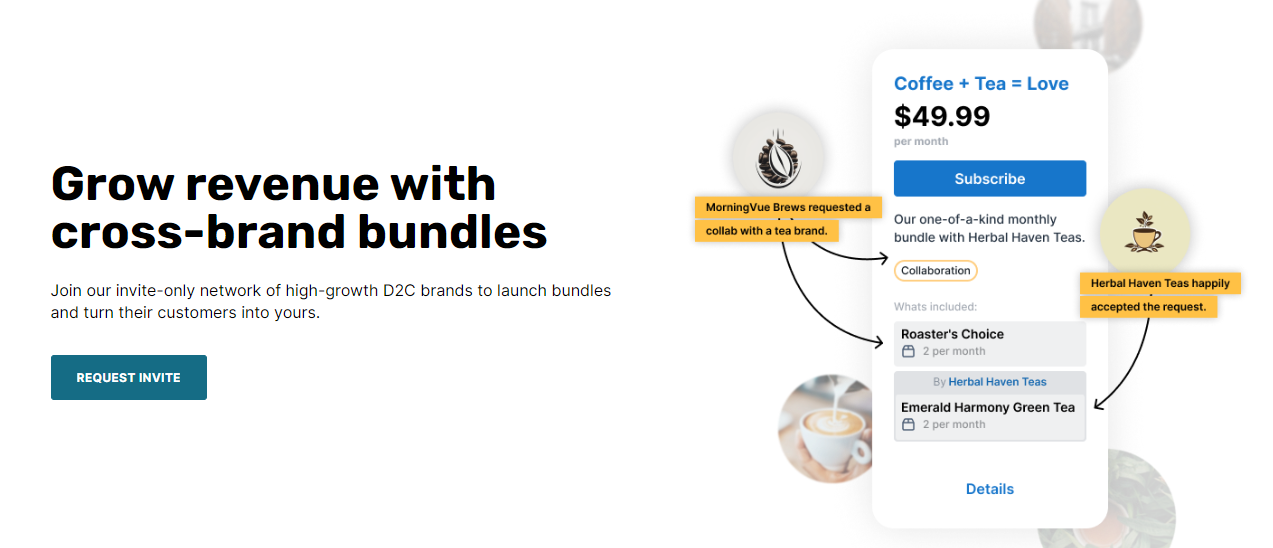Cross-Promotion: The Game Changer You're Ignoring
Cross-promotion is an effective type of partnership marketing that drives sales and revenue.
Looking to grow through collaboration? We've got your back with this simple guide to creating a partnership marketing strategy.
Follow this 5-step process to develop and execute a partnership marketing strategy:


A strategic partnership between two brands begins with setting goals which include your brand goals and shared goals.
You need to identify goals that you want to achieve from the partnership. Do you want to boost brand awareness, generate new leads, acquire new customers, or enter a new target market?
Also ask yourself the following question: Can you achieve these goals without partnership marketing?
This will help you overcome generic goals and give real meaning to collab-based marketing. The idea is to utilize the partnership fully by avoiding doing things that you can do easily without a partner. Try to do something that’s impossible to do without collaboration.
For example, Nike and Apple partnered together to reach new target markets and solve problems that were hard to tackle otherwise. Nike offered its customers an in-house app via Apple without having to spend resources on app development and design. Apple was able to collect customer data that helped it in numerous ways.
Instead of creating superficial business goals that you can achieve without a partner, it is a good idea to go after something that’s strategic.
Shared goals represent the common goals of both partners. This synergy is crucial for the success of the campaign. You need to make sure that the partner brand gets equal (if not more) value from the collab.
The first question your potential marketing partner would ask is: What’s in it for me?
Make sure you know the answer.
Choosing the right business partner is crucial for success. No matter how much effort you put into the partnership, if you are working with the wrong partner, it’ll lead nowhere.
When choosing a business partner, look for the following factors:
You both should have similar philosophies, visions, and strategic values. Simply put, your brand should go naturally with your partner. It should be a partnership that your customers should be expecting.
The best rule of like-mindedness is that there should be at least one commonality between the two businesses.
BMW and Louis Vuitton partnership made sense because both companies share similar creativity and style values. LV created custom designed luggage set for the BMW i8:

You need to pick partners that share similar values to avoid complications.
An ideal partner is one that doesn’t have a similar audience. There should be a specific target market that is common between the two partners.
If you both target the same audience, it won’t help because you will end up reaching the same audience that already knows you.
And the target audience shouldn’t be too different. For example, a joint venture between Zara and Raw Beauty would be disastrous as they don’t share any target market. In fact, they target two extremes.
What you need to look for is a target market that you and your partner have in common. A 15-20% overlap or similar audience demographics would work great.
The partnership between Taco Bell and Doritos that resulted in Doritos Locos Taco was a major hit because these two brands targeted an overlapping market:

These types of joint venture partnerships work well when a certain portion of the audience overlaps.
Do you have goals aligned with your partner?
When Forever 21 (a fashion brand) partnered with Atkins (a weight loss company), it turned out to be a failure. Forever 21 started sending free Atkin bars to its customers which didn’t do well as customers perceived it as body shaming:

This is what happens when you don’t have goals aligned and both partners work on individual goals.
You need to create shared goals that align with both brands. This is a reason why you should craft common goals when you are setting partnership goals for your business (see above). Focus on mutual benefits and how potential customers would benefit from this partnership.
Consider all the perspectives including customer perceptions when setting goals and finding a partner.
If you are a small business that’s not too popular yet, finding marketing collab opportunities will be challenging. You can look for brands on social media platforms, forums, and the internet.
You can check out Subkit to find tons of networking and collab opportunities. It is a collaboration platform that helps businesses earn via partnerships. You can find like minded businesses across several niches and join hands for cross-promotion and cross-marketing.
Subkit is free to use, give it a try today and connect with hundreds of businesses right away.
Once you have finalized an ideal partner for collaborative marketing, you need to finalize the collaboration marketing strategy. This step covers the nitty-gritty such as:
One of the major issues businesses face during collaborative marketing campaigns is disagreement over resources, data, participation efforts, and execution.
Most of these issues can be taken care of with proper documentation and sharing responsibilities equally. A great way is to prepare a detailed document for your collab marketing strategy with a plan of action, outcomes, duration, and metrics to measure success:

It should have:
For example, if your partner has a strong foothold in influencer marketing while you are good at email marketing, you should use these two marketing channels for cross-promotion and distribute tasks accordingly with relevant metrics to measure progress.
How you measure the success of channel partnerships is also critical. For example, if you are running a brand awareness collab marketing strategy, it will get complicated to measure outcomes. Defining and listing relevant metrics during the initial phase will keep you away from disagreements.
Disagreements aren’t always bad for partner relationships and joint product partnerships provided you address and solve them timely. A written document with all the responsibilities will keep things simple and will help you solve differences.
The execution phase is tricky. This is where the action begins.
A study reported that 56% of businesses cite lack of resources for execution as the biggest challenge they face when executing a partner marketing strategy while 50% of businesses mentioned difficulty in obtaining data to measure success as their biggest hurdle:

If you have done a decent job at defining a clear plan of action, partner roles, and everything is outlined, execution will get easier and less problematic.
As a strategic partner, you have two major responsibilities in the execution phase:
Constant communication during the execution phase is essential for the success of collaborative marketing. Managers cite effective internal communication and trust as a major success factor for joint ventures. As much as 44% of managers cite effective communication as a major success factor:

While you are busy in execution, don’t ignore your partner. Extend a helping hand in case of any issues. For example, a common reason for poor execution or lack of execution of the collab marketing strategy is issues in gaining partner attention as reported by 41% of businesses.
Follow these best practices to execute your partnership marketing strategy successfully:
This is the last step where you need to analyze the performance of the collaborative marketing campaigns and strategy. Refer to the KPIs defined in the goals phase to measure success.
For example, if the purpose of the partnership strategy was to increase brand awareness, you should use metrics like engagement rate, customer satisfaction, mentions, branded search volume, Google Trends, direct traffic, and others to measure success.
If the primary goal was lead generation, consider using metrics like the number of new leads, cost per acquisition, qualified leads, capture vs conversion rate, and others to track performance.
There isn’t a set of KPIs and metrics that’d work for all partnership marketing campaigns. Your goal defines what to measure and how to measure it.
However, a key metric that you should always measure is ROI (return on investment). And compare the collab marketing ROI with the ROI of other marketing channels. Is there a major difference?
If partnership marketing ROI is higher than any other marketing channel you have used, it’s a big hit and you know where to spend more money. The idea is to figure out if you should increase, decrease, or stop further investments in collaboration marketing strategy.
The problem with measuring ROI is that it gets hard to attribute leads and sales. It’s hard, for example, to identify the number of leads generated by your partner. It requires advanced tracking and attribution to ensure you accurately credit leads and sales to the right source.
Subkit offers a complete suite of partnership marketing for DTC brands that is ideal for reaching new audiences, growing customer base, and acquiring new customers at a low cost. It provides you with the tools and resources to connect with other businesses via product bundling, meaning you can also generate sales and passive income with other brands doing their share of the heavy lifting.
Subkit makes collaborative marketing easier because it is specifically designed for brands and focuses on co-marketing. Our platform allows you to try it risk-free and provides instant access to partnership opportunities!
Cross-promotion is an effective type of partnership marketing that drives sales and revenue.
Partnership marketing is ushering in a new era of collaboration and innovation for e-commerce brands seeking exponential growth.
Discover the easy way to find your perfect brand partner – leverage these simple tips to establish a strong foundation for enduring business success!
Receive an email when new blog posts are published.